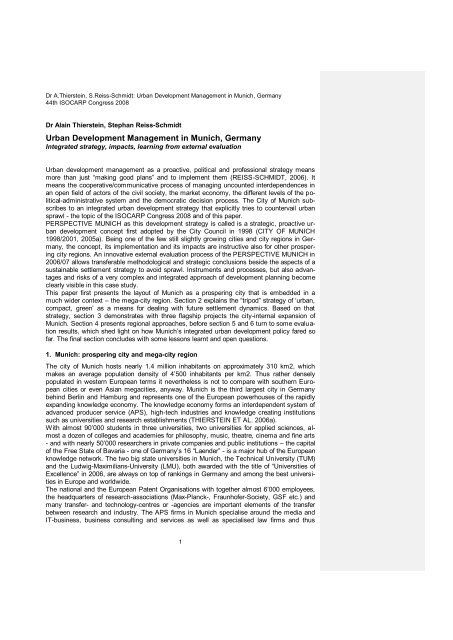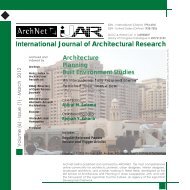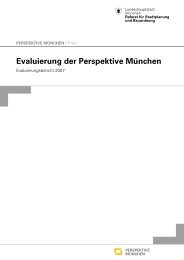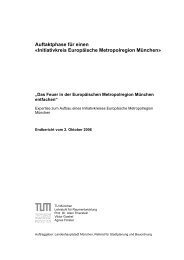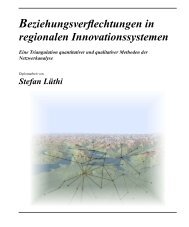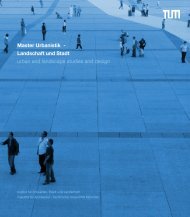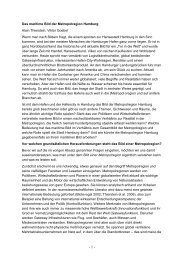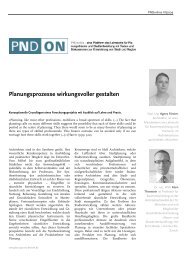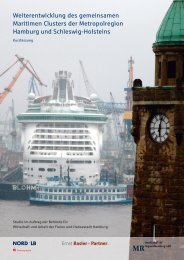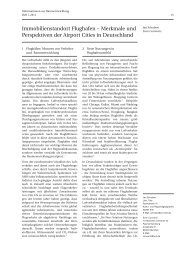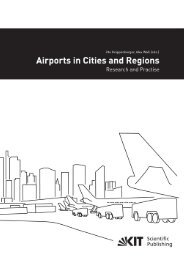Urban Development in Munich - Raumentwicklung TUM
Urban Development in Munich - Raumentwicklung TUM
Urban Development in Munich - Raumentwicklung TUM
Create successful ePaper yourself
Turn your PDF publications into a flip-book with our unique Google optimized e-Paper software.
Dr A.Thierste<strong>in</strong>, S.Reiss-Schmidt: <strong>Urban</strong> <strong>Development</strong> Management <strong>in</strong> <strong>Munich</strong>, Germany<br />
44th ISOCARP Congress 2008<br />
Dr Ala<strong>in</strong> Thierste<strong>in</strong>, Stephan Reiss-Schmidt<br />
<strong>Urban</strong> <strong>Development</strong> Management <strong>in</strong> <strong>Munich</strong>, Germany<br />
Integrated strategy, impacts, learn<strong>in</strong>g from external evaluation<br />
<strong>Urban</strong> development management as a proactive, political and professional strategy means<br />
more than just “mak<strong>in</strong>g good plans” and to implement them (REISS-SCHMIDT, 2006). It<br />
means the cooperative/communicative process of manag<strong>in</strong>g uncounted <strong>in</strong>terdependences <strong>in</strong><br />
an open field of actors of the civil society, the market economy, the different levels of the political-adm<strong>in</strong>istrative<br />
system and the democratic decision process. The City of <strong>Munich</strong> subscribes<br />
to an <strong>in</strong>tegrated urban development strategy that explicitly tries to countervail urban<br />
sprawl - the topic of the ISOCARP Congress 2008 and of this paper.<br />
PERSPECTIVE MUNICH as this development strategy is called is a strategic, proactive urban<br />
development concept first adopted by the City Council <strong>in</strong> 1998 (CITY OF MUNICH<br />
1998/2001, 2005a). Be<strong>in</strong>g one of the few still slightly grow<strong>in</strong>g cities and city regions <strong>in</strong> Germany,<br />
the concept, its implementation and its impacts are <strong>in</strong>structive also for other prosper<strong>in</strong>g<br />
city regions. An <strong>in</strong>novative external evaluation process of the PERSPECTIVE MUNICH <strong>in</strong><br />
2006/07 allows transferable methodological and strategic conclusions beside the aspects of a<br />
susta<strong>in</strong>able settlement strategy to avoid sprawl. Instruments and processes, but also advantages<br />
and risks of a very complex and <strong>in</strong>tegrated approach of development plann<strong>in</strong>g become<br />
clearly visible <strong>in</strong> this case study.<br />
This paper first presents the layout of <strong>Munich</strong> as a prosper<strong>in</strong>g city that is embedded <strong>in</strong> a<br />
much wider context – the mega-city region. Section 2 expla<strong>in</strong>s the “tripod” strategy of „urban,<br />
compact, green‟ as a means for deal<strong>in</strong>g with future settlement dynamics. Based on that<br />
strategy, section 3 demonstrates with three flagship projects the city-<strong>in</strong>ternal expansion of<br />
<strong>Munich</strong>. Section 4 presents regional approaches, before section 5 and 6 turn to some evaluation<br />
results, which shed light on how <strong>Munich</strong>‟s <strong>in</strong>tegrated urban development policy fared so<br />
far. The f<strong>in</strong>al section concludes with some lessons learnt and open questions.<br />
1. <strong>Munich</strong>: prosper<strong>in</strong>g city and mega-city region<br />
The city of <strong>Munich</strong> hosts nearly 1.4 million <strong>in</strong>habitants on approximately 310 km2, which<br />
makes an average population density of 4‟500 <strong>in</strong>habitants per km2. Thus rather densely<br />
populated <strong>in</strong> western European terms it nevertheless is not to compare with southern European<br />
cities or even Asian megacities, anyway. <strong>Munich</strong> is the third largest city <strong>in</strong> Germany<br />
beh<strong>in</strong>d Berl<strong>in</strong> and Hamburg and represents one of the European powerhouses of the rapidly<br />
expand<strong>in</strong>g knowledge economy. The knowledge economy forms an <strong>in</strong>terdependent system of<br />
advanced producer service (APS), high-tech <strong>in</strong>dustries and knowledge creat<strong>in</strong>g <strong>in</strong>stitutions<br />
such as universities and research establishments (THIERSTEIN ET AL. 2006a).<br />
With almost 90‟000 students <strong>in</strong> three universities, two universities for applied sciences, almost<br />
a dozen of colleges and academies for philosophy, music, theatre, c<strong>in</strong>ema and f<strong>in</strong>e arts<br />
- and with nearly 50‟000 researchers <strong>in</strong> private companies and public <strong>in</strong>stitutions – the capital<br />
of the Free State of Bavaria - one of Germany‟s 16 “Laender” - is a major hub of the European<br />
knowledge network. The two big state universities <strong>in</strong> <strong>Munich</strong>, the Technical University (<strong>TUM</strong>)<br />
and the Ludwig-Maximilians-University (LMU), both awarded with the title of “Universities of<br />
Excellence” <strong>in</strong> 2006, are always on top of rank<strong>in</strong>gs <strong>in</strong> Germany and among the best universities<br />
<strong>in</strong> Europe and worldwide.<br />
The national and the European Patent Organisations with together almost 6‟000 employees,<br />
the headquarters of research-associations (Max-Planck-, Fraunhofer-Society, GSF etc.) and<br />
many transfer- and technology-centres or -agencies are important elements of the transfer<br />
between research and <strong>in</strong>dustry. The APS firms <strong>in</strong> <strong>Munich</strong> specialise around the media and<br />
IT-bus<strong>in</strong>ess, bus<strong>in</strong>ess consult<strong>in</strong>g and services as well as specialised law firms and thus<br />
1
Dr A.Thierste<strong>in</strong>, S.Reiss-Schmidt: <strong>Urban</strong> <strong>Development</strong> Management <strong>in</strong> <strong>Munich</strong>, Germany<br />
44th ISOCARP Congress 2008<br />
complete the picture of a very successful knowledge region. The “Deutsches Museum”, Germany‟s<br />
lead<strong>in</strong>g technical and science museum, is a successful bridge between science and<br />
the public. They represent <strong>Munich</strong>‟s ma<strong>in</strong> manufactur<strong>in</strong>g branches like automotive, aircraft-<br />
and space-<strong>in</strong>dustry, medical technologies, nano-technology and optical technology.<br />
To understand <strong>Munich</strong> is to look at its role with<strong>in</strong> the mega-city region of <strong>Munich</strong>. The outskirts<br />
of the city for decades grew <strong>in</strong>to the region along the ma<strong>in</strong> transportation <strong>in</strong>frastructure<br />
l<strong>in</strong>es, fuelled by low mobility costs, abundance of ready-to-build land and lifestyle expectations<br />
of liv<strong>in</strong>g “<strong>in</strong> the green”. The first suburban r<strong>in</strong>g with<strong>in</strong> the <strong>Munich</strong> Regional Plann<strong>in</strong>g Region<br />
has 2.6 million, the wider mega-city region (“Europäische Metropolregion<br />
München”/”<strong>Munich</strong> Metropolitan Region”) nearly 5 million <strong>in</strong>habitants, <strong>in</strong>clud<strong>in</strong>g medium sized<br />
cities like Augsburg, Ingolstadt, Landshut and Rosenheim.<br />
Figure 1 left: Network of mega-city regions <strong>in</strong> Europe - <strong>Munich</strong> is the south-east corner of the “pentagon”<br />
(source: ESPON 2004; middle: 11 mega-city regions <strong>in</strong> Germany (source: BBR/Federal Office<br />
for Build<strong>in</strong>g and Territorial Plann<strong>in</strong>g); right: <strong>Munich</strong> Metropolitan Region <strong>in</strong> Bavaria (source: City of<br />
<strong>Munich</strong>)<br />
2. <strong>Urban</strong>, compact, green – <strong>in</strong>tegrated strategies for future settlement<br />
Today the <strong>Munich</strong> area still keeps its lead<strong>in</strong>g edge <strong>in</strong> Germany as be<strong>in</strong>g the economic power<br />
house of the knowledge economy, thus constantly attract<strong>in</strong>g people, firms and purchas<strong>in</strong>g<br />
power <strong>in</strong>to the area: re-urbanisation has a new show case. The population of the city of <strong>Munich</strong><br />
will grow further accord<strong>in</strong>g to recent forecast ma<strong>in</strong>ly by immigration from other parts of<br />
Germany and Europe by 5 percent until the year 2020; the region even more by more than 10<br />
percent. Expected is an <strong>in</strong>creas<strong>in</strong>g number of commuters not only from the suburban fr<strong>in</strong>ge,<br />
but also from the second and third r<strong>in</strong>gs <strong>in</strong> a distance of up to 80 kilometres. Today, only 48<br />
percent of the more than 300‟000 job commuters use public transport. Additional shopp<strong>in</strong>g<br />
and leisure commut<strong>in</strong>g mostly by car and the city and of course the goods traffic leads to a<br />
total public transport ratio between region and city of only 30%. All together with the throughtraffic,<br />
more than 500‟000 cars every day cross the city boundaries and <strong>in</strong> 2015 it even could<br />
be up to 30 percent more. Increas<strong>in</strong>g congestion, noise and air pollution will be the consequence,<br />
if the trends of suburbanisation, lower densities and <strong>in</strong>creas<strong>in</strong>g numbers of commuters<br />
with private cars could not be stopped by an <strong>in</strong>tegrated policy mix of us<strong>in</strong>g all potentials<br />
for <strong>in</strong>ner urban hous<strong>in</strong>g development, improvement of the regional public rail transport (S-<br />
Bahn; Light Rail System) and <strong>in</strong>ter-modality (Park&Ride, Bike&Ride).<br />
2<br />
Kommentar [Thierstei1]: SL<br />
U: kannst du da die Grafik aufs<br />
nötigste neu zuschneiden bzw. mit<br />
wenig kB e<strong>in</strong>fügen?
Dr A.Thierste<strong>in</strong>, S.Reiss-Schmidt: <strong>Urban</strong> <strong>Development</strong> Management <strong>in</strong> <strong>Munich</strong>, Germany<br />
44th ISOCARP Congress 2008<br />
Figure 2 left: Preferred settlement areas (red), situated at railway-stops (S-Bahn) accord<strong>in</strong>g Regional<br />
Plan; right: <strong>Development</strong> of traffic (rides) 2000 - 2015 – city (yellow) and surround<strong>in</strong>g region (grey),<br />
scenario: <strong>Munich</strong> traffic development plan (source: City of <strong>Munich</strong>)<br />
The city recognises to be function<strong>in</strong>g only with<strong>in</strong> a wider city-region delimitation - the megacity<br />
region of <strong>Munich</strong>. Thus be<strong>in</strong>g the primary city, <strong>Munich</strong> assumes responsibility to susta<strong>in</strong>ably<br />
deal with its resources <strong>in</strong> order not to foster unwanted urban sprawl and <strong>in</strong>creas<strong>in</strong>g mobility<br />
with private cars. Prevent<strong>in</strong>g <strong>in</strong>creas<strong>in</strong>g CO2-emissions fac<strong>in</strong>g accelerated climate<br />
change and even the <strong>in</strong>creas<strong>in</strong>g costs of commut<strong>in</strong>g-mobility and <strong>in</strong>frastructure for a suburbanised,<br />
low-density settlement strategy call for action <strong>in</strong> cooperation of city and regional<br />
plann<strong>in</strong>g authorities.<br />
On the local level <strong>Munich</strong> has a very elaborated <strong>in</strong>tegrated development concept, the “PER-<br />
SPECTIVE MUNICH”, which follows the pr<strong>in</strong>ciples of “susta<strong>in</strong>ability and urbanity”.<br />
Economic prosperity, regional cooperation, social balance and equity, <strong>in</strong>ner development of<br />
the city <strong>in</strong>stead of sprawl, and a susta<strong>in</strong>able mobility for all citizens are some of its guidel<strong>in</strong>es.<br />
The city‟s strategic guidel<strong>in</strong>e for spatial development is labelled “compact, urban, green”.<br />
In l<strong>in</strong>e with its <strong>in</strong>tegrated, long-term-approach - which has a tradition of 45 years of <strong>in</strong>tegrated<br />
development plann<strong>in</strong>g – the guid<strong>in</strong>g pr<strong>in</strong>ciples and strategies of PERSPECTIVE MUNICH<br />
centre on the city as a whole, as well as on the surround<strong>in</strong>g region. With<strong>in</strong> the framework of<br />
path f<strong>in</strong>d<strong>in</strong>g-projects and local or sectoral concepts as well as action programmes – for <strong>in</strong>stance<br />
for traffic development or assignment of hous<strong>in</strong>g and retail uses – these pr<strong>in</strong>ciples are<br />
then given concrete form. Key to countervail unwanted urban sprawl is two transversal<br />
strategies of the PERSPECTIVE MUNICH: “<strong>in</strong>ternal expansion” and “urban, compact, green”.<br />
In the <strong>in</strong>terest of susta<strong>in</strong>ability, the use of previously undeveloped, unsealed land must be<br />
sharply reduced when new residential areas are be<strong>in</strong>g developed. The focus of <strong>in</strong>ternal expansion<br />
lies on concepts designed to reuse and restructure exist<strong>in</strong>g build up areas fallen out<br />
of their use (“Flächenkreislaufwirtschaft”) - for <strong>in</strong>stance former <strong>in</strong>dustrial or railway land and<br />
former military barracks that lie with<strong>in</strong> city-limits.<br />
As a result of the privatisation of the federal railway and postal as well as telecommunication<br />
services and the reduction of military force – both of the German and the Allied forces - at the<br />
beg<strong>in</strong>n<strong>in</strong>g of the 1990s, <strong>Munich</strong> experienced a „w<strong>in</strong>dfall‟ ga<strong>in</strong> <strong>in</strong> the form of a huge amount of<br />
<strong>in</strong>ner city development resources – without reduc<strong>in</strong>g scarce open space. More than 60‟000<br />
hous<strong>in</strong>g dwell<strong>in</strong>gs could be realised on these <strong>in</strong>ternal expansion sites. For most users it is<br />
very attractive to concentrate activities on these restructur<strong>in</strong>g areas s<strong>in</strong>ce they are embedded<br />
<strong>in</strong> exist<strong>in</strong>g <strong>in</strong>frastructure, available and partly reusable build<strong>in</strong>gs and mostly have rather good<br />
<strong>in</strong>tegration <strong>in</strong>to the public transport network. The already exist<strong>in</strong>g urban context offers the<br />
chance to ameliorate neighbour<strong>in</strong>g areas by new hous<strong>in</strong>g, more open space and a better social<br />
<strong>in</strong>frastructure.<br />
3
Dr A.Thierste<strong>in</strong>, S.Reiss-Schmidt: <strong>Urban</strong> <strong>Development</strong> Management <strong>in</strong> <strong>Munich</strong>, Germany<br />
44th ISOCARP Congress 2008<br />
One of the city‟s top priorities <strong>in</strong> hous<strong>in</strong>g is to annually complete 6‟000 to 7‟000 units. This<br />
objective can first be achieved by <strong>in</strong>ternal expansion as just described and second by additional<br />
options like densification of exist<strong>in</strong>g hous<strong>in</strong>g areas by fill<strong>in</strong>g gaps, add<strong>in</strong>g further floors<br />
etc. A third option is build<strong>in</strong>g up some areas at the periphery of the city-limits designated<br />
s<strong>in</strong>ce long <strong>in</strong> the land use plan for development. But s<strong>in</strong>ce a clear priority lies on the <strong>in</strong>ternal<br />
expansion, peripheral development only takes place on these designated sites, if and <strong>in</strong> so<br />
far, as the <strong>in</strong>ternal restructur<strong>in</strong>g areas are not sufficient to cover the demand for new hous<strong>in</strong>g.<br />
“Compact, urban, green” as one of <strong>Munich</strong>‟s key strategies for spatial development comb<strong>in</strong>es<br />
dense urban land use for all purposes with the promotion of mixed use developments when<br />
ever possible <strong>in</strong>stead of mono-functional commercial or hous<strong>in</strong>g areas. Together with the<br />
polycentric system of district-centres that spread over the entire city the mixed use approach<br />
will also secure a density of social life and short distances for many citizens to get to their<br />
jobs, schools and shops. This will help to <strong>in</strong>crease walk<strong>in</strong>g and cycl<strong>in</strong>g and us<strong>in</strong>g public<br />
transport <strong>in</strong>stead of private cars for the every day mobility. “Internal expansion” and “compact,<br />
urban, green” seem t<strong>in</strong>y contributions to mitigat<strong>in</strong>g climate change and the necessity to reduce<br />
CO2 production. Nevertheless they are very important elements for susta<strong>in</strong>able urban<br />
growth, not only <strong>in</strong> European cities.<br />
Figure 3 left: Spatial development guidel<strong>in</strong>e “compact, urban, green”; right: potential areas for <strong>in</strong>ternal<br />
expansion (source: City of <strong>Munich</strong>)<br />
The notion of “green” <strong>in</strong> this context implies, that parks and green open spaces <strong>in</strong> the city<br />
must not only be safeguarded and enhanced, but also significantly augmented <strong>in</strong> quantity.<br />
The rule <strong>in</strong> <strong>Munich</strong> is, that for every <strong>in</strong>habitant <strong>in</strong> new build residential areas 17 m2 of green<br />
open space <strong>in</strong> new public parks have to be provided. An important element of the strategy is<br />
the knitt<strong>in</strong>g of a network of green open spaces. It is constituted by regional green belts, big<br />
parks, green river banks, <strong>in</strong>ner-city green belts or district parks and sport facilities like the<br />
world famous Olympic Park of the1972 Olympic Games, which is still one of the most frequented<br />
parks <strong>in</strong> <strong>Munich</strong> for sports, leisure and enterta<strong>in</strong>ment.<br />
3. Three flagship projects of <strong>Munich</strong>’s <strong>in</strong>ternal expansion strategy<br />
3.1. Central railway lands<br />
The central railway lands are situated between <strong>Munich</strong>‟s ma<strong>in</strong> station and the station of Pas<strong>in</strong>g,<br />
eight kilometres west of the city centre. These not yet adequately used former railway<br />
lands are cover<strong>in</strong>g 170 hectares. In 1997, based on a master-contract between the Federal<br />
Railway Company, their land development agencies and the city of <strong>Munich</strong> a complex plann<strong>in</strong>g<br />
process started to develop five <strong>in</strong>dependent new quarters for up to 19‟000 jobs and<br />
16‟000 <strong>in</strong>habitants with an amount of nearly 70 hectares of new green open space. The Railway<br />
Company and federal government as owners agreed to realise or to pay for all necessary<br />
4
Dr A.Thierste<strong>in</strong>, S.Reiss-Schmidt: <strong>Urban</strong> <strong>Development</strong> Management <strong>in</strong> <strong>Munich</strong>, Germany<br />
44th ISOCARP Congress 2008<br />
green, social and traffic <strong>in</strong>frastructure - and for all costs of architectural competitions, plann<strong>in</strong>g<br />
documents and special expertises on environmental, traffic and other related aspects.<br />
The new created quarters are <strong>in</strong>tegrated <strong>in</strong>to their respective exist<strong>in</strong>g neighbourhoods and<br />
create new opportunities for their <strong>in</strong>habitants with new parks, cultural and shopp<strong>in</strong>g establishments,<br />
new schools, k<strong>in</strong>dergartens and nurseries. Pas<strong>in</strong>g serves more than 75‟000 travellers<br />
per day, thus be<strong>in</strong>g the fourth largest node of all railway stations <strong>in</strong> Bavaria. Around that<br />
railway node, a new shopp<strong>in</strong>g mall on former railway land will strengthen and help to modernize<br />
the traditional district centre.<br />
A transversal east-west cycl<strong>in</strong>g path, <strong>in</strong>dependent from car traffic and parallel to the rema<strong>in</strong><strong>in</strong>g<br />
railway tracks cross<strong>in</strong>g the new green open spaces will <strong>in</strong> the near future help to connect<br />
the <strong>in</strong>ner city with the western districts of <strong>Munich</strong> - attractive and fast for the <strong>in</strong>creas<strong>in</strong>g number<br />
of cyclists <strong>in</strong> <strong>Munich</strong>. Today, approximately 10 percent of all rides <strong>in</strong> <strong>Munich</strong> are made by<br />
bicycle, for 2015 the target is 15 percent.<br />
Figure 4: Central railway lands, master plan (source: City of <strong>Munich</strong>)<br />
In order to secure a social mix of groups with different <strong>in</strong>comes, <strong>in</strong> every of the five quarters<br />
30 percent of the residential floor space is designated for public subsidised hous<strong>in</strong>g for low<br />
and middle <strong>in</strong>come groups, preferably families with two or more children.<br />
The plann<strong>in</strong>g process for this complex project had been organised <strong>in</strong> a cooperative management<br />
process between the city of <strong>Munich</strong>, the landowners and an <strong>in</strong>creas<strong>in</strong>g number of private<br />
partners, who had sold pieces of the former railway land for development. S<strong>in</strong>ce the<br />
whole area is be<strong>in</strong>g planned and built-up by a huge number of different private and some<br />
public developers the city of <strong>Munich</strong> organised regularly urban and landscape plann<strong>in</strong>g competitions<br />
<strong>in</strong> order to secure quality of the urban plann<strong>in</strong>g and the architecture of the s<strong>in</strong>gle<br />
build<strong>in</strong>gs, as well as for each quarter. For many of the s<strong>in</strong>gle build<strong>in</strong>gs and for the new public<br />
parks architectural realis<strong>in</strong>g competitions followed. An advisory commission of architects and<br />
landscape architects supervises the realisation process and discusses every concrete project<br />
before it gets build<strong>in</strong>g permission.<br />
In all of the five quarters build<strong>in</strong>g of houses and plant<strong>in</strong>g of some thousand new trees had begun.<br />
The most <strong>in</strong>ner-city quarter – the „Arnulfpark‟ – has already hous<strong>in</strong>g and a new park,<br />
which have been completed <strong>in</strong> 2006. Arnulfpark today has already reached half of its envisaged<br />
capacity. Until 2012 the four quarters will be completed and the fifth and last will be under<br />
construction.<br />
5
Dr A.Thierste<strong>in</strong>, S.Reiss-Schmidt: <strong>Urban</strong> <strong>Development</strong> Management <strong>in</strong> <strong>Munich</strong>, Germany<br />
44th ISOCARP Congress 2008<br />
3.2. Trade Fair City of Riem, former airport<br />
After 30 years of discussion, plann<strong>in</strong>g and build<strong>in</strong>g, 1992 the <strong>Munich</strong> International Airport<br />
was relocated from the eastern quarter of Riem (with<strong>in</strong> the city boundaries) to Erd<strong>in</strong>g, some<br />
36 kilometres northeast of <strong>Munich</strong>. As a result of an <strong>in</strong>ternational plann<strong>in</strong>g competition, one<br />
third of the 560 hectares of land that was owned by the city of <strong>Munich</strong> was designated to be<br />
home of the new trade fair. The trade fair until then was squeezed <strong>in</strong> its <strong>in</strong>ner-city location at<br />
the Theresienhöhe, only five m<strong>in</strong>utes distance from the ma<strong>in</strong> railway station. The second<br />
third of former airport land – thus follow<strong>in</strong>g the philosophy of “compact, urban, green” – was<br />
dedicated to mixed residential, manufactur<strong>in</strong>g, office and commercial use. The last third was<br />
to be developed as a new public park with approximately 200 hectares. Dwell<strong>in</strong>gs for 16‟000<br />
<strong>in</strong>habitants and approximately 13‟000 work places will be created until 2015. The public<br />
transport connection to the <strong>in</strong>ner city districts was planned by an extension of metro l<strong>in</strong>e 2,<br />
which was completed <strong>in</strong> 1999. 1998 the new trade fair was opened <strong>in</strong> Riem. The first <strong>in</strong>habitants<br />
came to the new quarter <strong>in</strong> the same year today almost 7‟000 live <strong>in</strong> the “Trade Fair City<br />
of Riem”. The very attractive “Riemer Park” with an artificial bath<strong>in</strong>g lake for the summer and<br />
a skeleton hill for the w<strong>in</strong>ter season was opened 2005 with the event of a Federal Garden Exhibition.<br />
Figure 5: Trade Fair City of Riem, left: master plan, right: aerial view of <strong>in</strong>frastructure zone between<br />
hous<strong>in</strong>g and park (source: City of <strong>Munich</strong>)<br />
For a more or less mixed social structure, up to 70 percent of subsidised hous<strong>in</strong>g was realised<br />
<strong>in</strong> the first parts of the new quarter and 50 percent <strong>in</strong> the latest portions. One result of<br />
this decision is the fact, that today the Trade Fair City of Riem is one of the quarters <strong>in</strong> <strong>Munich</strong>,<br />
where most families with children live, so that a third elementary school had to be implemented<br />
earlier than expected.<br />
2005 at “half time” of the development of this new quarter, an external evaluation had been<br />
undertaken and showed some <strong>in</strong>terest<strong>in</strong>g results, as well as risks and open questions <strong>in</strong> implement<strong>in</strong>g<br />
the guidel<strong>in</strong>e of “compact, urban green” (CITY OF MUNICH 2005b). Trade Fair<br />
City of Riem was designated as a guidel<strong>in</strong>e-project with<strong>in</strong> the framework of PERSPECTIVE<br />
MUNICH - the urban development concept – and so far is a success story. It had proven that<br />
the decision to reuse the former airport land for a “three-thirds-strategy” with new trade fair,<br />
mixed city quarter an new public landscape park was a future oriented concept with enough<br />
built-<strong>in</strong> flexibility to meet chang<strong>in</strong>g needs and conditions dur<strong>in</strong>g an overall plann<strong>in</strong>g and realisation<br />
period of more than 30 years.<br />
3.3. Theresienhoehe, former trade fair area<br />
Follow<strong>in</strong>g the decision to relocate the trade fair from the <strong>in</strong>ner city to the former airport site <strong>in</strong><br />
the Trade Fair City of Riem – 45 hectares of valuable land – <strong>in</strong>tegrated <strong>in</strong> the exist<strong>in</strong>g metro<br />
network became available, which fortunately was owned by the city of <strong>Munich</strong>. Follow<strong>in</strong>g the<br />
6
Dr A.Thierste<strong>in</strong>, S.Reiss-Schmidt: <strong>Urban</strong> <strong>Development</strong> Management <strong>in</strong> <strong>Munich</strong>, Germany<br />
44th ISOCARP Congress 2008<br />
guidel<strong>in</strong>e “compact, urban, green” 1996, two years before the fair was to be relocated, an <strong>in</strong>ternational<br />
plann<strong>in</strong>g competition was started. The prizew<strong>in</strong>ner‟s idea was to create a dense<br />
and lively <strong>in</strong>ner city quarter <strong>in</strong> the tradition of the European City, based on a grid of build<strong>in</strong>g<br />
blocks of 70 by 70 metres. Public streets and squares <strong>in</strong>corporat<strong>in</strong>g references to the<br />
neighbour<strong>in</strong>g quarters with great flexibility for the plann<strong>in</strong>g of the <strong>in</strong>dividual lots show, that the<br />
rules of the European City are still suitable for urban developments of to morrow. In the middle<br />
of the Theresienhöhe quarter the historic Bavaria Park with its 150 years old huge trees<br />
focuses the attention and gives the new quarter a historic dimension and a very specific identity.<br />
25 percent of the quarter is designated as park, promenade, play ground or car free<br />
public space for recreation and leisure activities.<br />
Figure 6: Theresienhöhe <strong>in</strong>ner city quarter, left: master plan, architect Prof. Otto Steidle, right: impression<br />
from the northern part (source: City of <strong>Munich</strong>)<br />
Today the new quarter for approximately 3‟000 <strong>in</strong>habitants and up to 5‟000 workplaces is almost<br />
completed, <strong>in</strong>clud<strong>in</strong>g a new elementary school, several k<strong>in</strong>dergartens and nurseries, a<br />
youth centre and a beer-garden beside the historic congress hall and the museum halls. Despite<br />
the <strong>in</strong>ner city location and the high land value, city council decided accord<strong>in</strong>g to the social<br />
policy guidel<strong>in</strong>es of PERSPECTIVE MUNICH to realise 50 percent of the dwell<strong>in</strong>gs as<br />
subsidised hous<strong>in</strong>g for low and middle-<strong>in</strong>come groups.<br />
In the few years s<strong>in</strong>ce the old trade fair site has been developed <strong>in</strong>to a new urban quarter<br />
Theresienhöhe, it has already proven as perhaps be<strong>in</strong>g the best of all the examples for “compact,<br />
urban, green” so far implemented. At least it is proof of the advantages that accrue by<br />
follow<strong>in</strong>g a coherent <strong>in</strong>ternal expansion strategy. The result is the emergence of a urban and<br />
lively quarter that displays a comb<strong>in</strong>ation of hybrid uses with high density and a significant<br />
amount of open spaces as well as green areas that have been structured accord<strong>in</strong>g very demand<strong>in</strong>g<br />
legal standards.<br />
4. Regional approaches - “Settlement and mobility-project”<br />
A Regional Plan exists s<strong>in</strong>ce 25 years, which roughly def<strong>in</strong>es regional green belts and areas<br />
preferred for settlement, focussed on the corridors of the regional rail system (S-Bahn). Pr<strong>in</strong>ciples<br />
and objectives are formulated <strong>in</strong> the accompany<strong>in</strong>g text of the Regional Plan for settlement,<br />
green, bus<strong>in</strong>ess and retail as well as transportation <strong>in</strong>frastructure. The implementation<br />
of this plan is not str<strong>in</strong>gent s<strong>in</strong>ce plann<strong>in</strong>g authority <strong>in</strong> Germany is fragmented accord<strong>in</strong>g<br />
to its decentralised federalist state system. Based on constitutional rights of local selfgovernment,<br />
the responsibility for all land-use and build<strong>in</strong>g regulations lies with the 185 small<br />
7
Dr A.Thierste<strong>in</strong>, S.Reiss-Schmidt: <strong>Urban</strong> <strong>Development</strong> Management <strong>in</strong> <strong>Munich</strong>, Germany<br />
44th ISOCARP Congress 2008<br />
and medium sized local authorities and their respective territories. In order to promote <strong>in</strong>termunicipal<br />
cooperation with regards to susta<strong>in</strong>able settlement and mobility issues one is left<br />
with develop<strong>in</strong>g so called „w<strong>in</strong>-w<strong>in</strong> solutions‟ on a voluntary basis. Recent product of this soft<br />
and “persuasive” cooperation strategy is an action-oriented research study project called “Settlement<br />
<strong>Development</strong> and Mobility <strong>in</strong> the <strong>Munich</strong> Region” (PLANUNGSVERBAND 2008).<br />
This project is jo<strong>in</strong>tly f<strong>in</strong>anced by the city, the Plann<strong>in</strong>g Association of the Region of <strong>Munich</strong>,<br />
the <strong>Munich</strong> Public Transport Association (MVV) and co-f<strong>in</strong>anced by the Bavarian State M<strong>in</strong>istry<br />
of the Interior. This study whose first part was completed <strong>in</strong> March 2008, shows on the<br />
one hand <strong>in</strong> detail the non built-up land reserves with<strong>in</strong> a radius of 2‟000 meters around exist<strong>in</strong>g<br />
and planned railway stations. These reserves thus form the potential for hous<strong>in</strong>g and sum<br />
up to 1‟220 hectares (municipal reserve land not <strong>in</strong>cluded), which will be good for up to<br />
40‟000 hous<strong>in</strong>g units – depend<strong>in</strong>g on density. Look<strong>in</strong>g at the population projection these reserves<br />
will cover nearly 80 percent of the needs for additional hous<strong>in</strong>g outside the city itself<br />
up to the year 2020. Additional 1‟200 hectares are available around the railway stations for<br />
manufactur<strong>in</strong>g, offices, mixed and different special uses.<br />
With<strong>in</strong> the city, almost all of the long term development land reserve for hous<strong>in</strong>g of approximately<br />
800 hectares for up to 60‟000 additional dwell<strong>in</strong>gs lie with<strong>in</strong> 1‟000 meter of an S-<br />
Bahn, Metro or Tram stop.<br />
On the other hand, the study shows the exist<strong>in</strong>g and planned public transport structure (rail,<br />
bus, P&R, B&R). A third issue of the project looks at mobility costs based on a complex calculation<br />
model for different owner/occupier-types of households and for every city or local<br />
community area <strong>in</strong> the region. The model will be able to show overall repercussions – <strong>in</strong><br />
comb<strong>in</strong>ation with the average land prices <strong>in</strong> the different areas of the region – that <strong>in</strong>dividual<br />
decisions for presumably cheap land but badly connected to public transport will have for private<br />
households.<br />
In the second phase of this research project, five to ten different types of local areas (cities,<br />
villages <strong>in</strong> different distances from <strong>Munich</strong> and with different quality of public (rail) transport)<br />
will be screened more <strong>in</strong> detail. The objective is to come up with strategies and practical<br />
suggestions for <strong>in</strong>tegrated local settlement and mobility policy that is <strong>in</strong> accordance with the<br />
Regional Plan and the pr<strong>in</strong>ciples of compact urban development that is to concentrate new<br />
hous<strong>in</strong>g preferably with<strong>in</strong> the 2‟000 meter-radius around the rail stations. An additional research<br />
module will focus on the overall <strong>in</strong>frastructure cost that accrue for different types of<br />
settlement configurations: served by rail stations, B&R/P&R <strong>in</strong>termodality with high densities,<br />
low-density sprawl-development not connected to public transportation. The comb<strong>in</strong>ation of<br />
spatial, urbanist, traffic and economic approaches should <strong>in</strong>tensify a broad political discussion<br />
about the future settlement and mobility strategies <strong>in</strong> the <strong>Munich</strong> Region.<br />
The Regional Plann<strong>in</strong>g Association alone does not gather enough legal competencies to execute<br />
the necessary operational power. It would be necessary to create a special and operative<br />
regional agency for settlement and <strong>in</strong>frastructure development, to take action <strong>in</strong> this respect<br />
and to secure the social and spatial balance with<strong>in</strong> the entire region. Such an advanced body<br />
still is not <strong>in</strong> sight; even the debate about its relevance has not really been started. Local selfgovernance<br />
as well as voluntary, <strong>in</strong>formal cooperation are today the only exist<strong>in</strong>g forms - for<br />
<strong>in</strong>stance <strong>in</strong> the Association for Recreation Areas, <strong>in</strong> the Plann<strong>in</strong>g Association or <strong>in</strong> the recent<br />
Initiative European Metropolitan Region <strong>Munich</strong> (REISS-SCHMIDT 2003, THIERSTEIN ET<br />
AL. 2006b).<br />
5. Evaluation PM – methodology and process<br />
PERSPECTIVE MUNICH calls for regularly be<strong>in</strong>g reviewed and adapted to chang<strong>in</strong>g conditions.<br />
Aga<strong>in</strong>st a background of social and economic change, it is also <strong>in</strong>tended, from time to<br />
time to review the underly<strong>in</strong>g pr<strong>in</strong>ciples of PERSPECTIVE MUNICH. The follow<strong>in</strong>g sections<br />
present results of the first external <strong>in</strong>ter-mediate evaluation of this <strong>in</strong>tegrated urban development<br />
strategy. A special focus emphasises methodological issues of how to make a transversal,<br />
comprehensive urban strategy assessable and generally formulated objectives tangible.<br />
8
Dr A.Thierste<strong>in</strong>, S.Reiss-Schmidt: <strong>Urban</strong> <strong>Development</strong> Management <strong>in</strong> <strong>Munich</strong>, Germany<br />
44th ISOCARP Congress 2008<br />
External impact evaluations of policy programmes can either adopt a facts-only approach or<br />
subscribe to a more participatory approach. This case study follows the latter by comb<strong>in</strong><strong>in</strong>g a<br />
mixture of <strong>in</strong>dicator-based analyses of <strong>in</strong>dividual strategic objectives with a qualitative approach.<br />
Participatory, qualitative approaches usually are chosen <strong>in</strong> order to grasp more comprehensively<br />
the complex <strong>in</strong>ter-relationships between numerous strategic objectives and <strong>in</strong>dividual<br />
beacon projects. Figure 9 gives an overview of the particular methodology chosen by<br />
the external evaluators of the PERSPECTIVE MUNICH.<br />
A series of analyses of available impact <strong>in</strong>dicators that help assess the achievement of objectives<br />
as well as official documents and press releases produced the empirical basis for extensive<br />
<strong>in</strong>teraction with <strong>in</strong>-house practitioners as well as outside experts. A special emphasis<br />
was put on <strong>in</strong>volv<strong>in</strong>g the various responsible persons from the city of <strong>Munich</strong>. Individual <strong>in</strong>depth<br />
<strong>in</strong>terviews with <strong>in</strong>-house persons <strong>in</strong> charge of specific aspects of the guid<strong>in</strong>g pr<strong>in</strong>ciples<br />
and the projects def<strong>in</strong>ed <strong>in</strong> the PERSPECTIVE MUNICH, <strong>in</strong>-house group discussions, <strong>in</strong>terviews<br />
with the demand-side of the urban development strategy – the economy, civic groups,<br />
media, science, vocational associations, regional governance bodies – gave additional <strong>in</strong>sights<br />
and assessments of earlier factual f<strong>in</strong>d<strong>in</strong>gs. Inter-mittantly, prelim<strong>in</strong>ary results were fed<br />
back <strong>in</strong>to a steer<strong>in</strong>g committee. Two vision<strong>in</strong>g workshops with <strong>in</strong>-house as well as <strong>in</strong>ternational<br />
experts dealt with potential futures of the city of <strong>Munich</strong>.<br />
Fehler!<br />
Assessment of<br />
achievement of objectives:<br />
pr<strong>in</strong>ciples &<br />
projects<br />
Assessment of decision<br />
mak<strong>in</strong>g and implementation<br />
processes<br />
Future challenges and options for improvement<br />
Recommendations<br />
To update and improve pr<strong>in</strong>ciples and organisational<br />
structure<br />
To redesign processes<br />
Indicator-based monitor<strong>in</strong>g system<br />
Figure 9: the various tasks of the external evaluation of PERSPECTIVE MUNICH (source:<br />
CITY OF MUNICH 2007)<br />
In the year 2007 the overall results were compiled first <strong>in</strong> a extended report <strong>in</strong>ternal to the<br />
public adm<strong>in</strong>istration. After open deliberation <strong>in</strong> the city council at the end of 2007 and early<br />
2008, a short version of the f<strong>in</strong>d<strong>in</strong>gs was f<strong>in</strong>ally released to the public <strong>in</strong> the summer of 2008<br />
via the city of <strong>Munich</strong>‟s official website (URL:<br />
http://www.muenchen.de/Rathaus/plan/stadtentwicklung/perspektive/umsetzung/159824/<strong>in</strong>d<br />
ex.html#eval). The follow<strong>in</strong>g section summarizes the ma<strong>in</strong> f<strong>in</strong>d<strong>in</strong>gs concern<strong>in</strong>g the overall<br />
assessment of the achievement of objectives and further questions dealt with <strong>in</strong> the external<br />
evaluation (figure 9).<br />
9<br />
Assessment of objectives<br />
and organisational<br />
structure
Dr A.Thierste<strong>in</strong>, S.Reiss-Schmidt: <strong>Urban</strong> <strong>Development</strong> Management <strong>in</strong> <strong>Munich</strong>, Germany<br />
44th ISOCARP Congress 2008<br />
6. Evaluation PM – results and recommendations<br />
The overall assessment of the external evaluators highlights the follow<strong>in</strong>g f<strong>in</strong>d<strong>in</strong>gs:<br />
PERSPECTIVE MUNICH manages to comb<strong>in</strong>e policy approaches that deal with the<br />
built environment and spatial urban development as well as with socio-economic issues<br />
key to the overall well be<strong>in</strong>g of a city of the importance of <strong>Munich</strong>.<br />
PERSPECTIVE MUNICH as an <strong>in</strong>tegrative approach represents a comprehensive attitude<br />
of urban development that seems prone to tackle the up-com<strong>in</strong>g challenges for<br />
<strong>Munich</strong>.<br />
PERSPECTIVE MUNICH documents the thorough and constant commitment to upgrade<br />
and redesign the long-stand<strong>in</strong>g <strong>Munich</strong> tradition of city plann<strong>in</strong>g.<br />
PERSPECTIVE MUNICH proves flexible an <strong>in</strong>strumtent to <strong>in</strong>corporate future key issues<br />
such as urban strategies on climate change, social <strong>in</strong>clusion or territorial governance.<br />
One of the core tasks was to assess the degree of achievement of objectives with regard to a<br />
selection of guid<strong>in</strong>g pr<strong>in</strong>ciples of the PERSPECTIVE MUNICH. Figure 10 summarises the<br />
results.<br />
Figure 10: Degree of achievement of objectives of guid<strong>in</strong>g pr<strong>in</strong>ciples of the PERSPECTIVE<br />
MUNICH (source: CITY OF MUNICH 2007)<br />
Figure 10 shows for each guid<strong>in</strong>g pr<strong>in</strong>ciple the average assessement of all respective partial<br />
goals. The spread <strong>in</strong> the assessment of the <strong>in</strong>dividual partial goals is represented by the width<br />
of the fad<strong>in</strong>g-out colored bar. A read<strong>in</strong>g example clarifies the <strong>in</strong>terpretation of the figure above.<br />
The highest degree <strong>in</strong> achiev<strong>in</strong>g the objectives set by the PERSPECTIVE MUNICH are attributed<br />
to the pr<strong>in</strong>ciples of „qualified <strong>in</strong>ner-city development – compact, urban, green‟,<br />
„strengthen<strong>in</strong>g <strong>in</strong>dividual parts of the city through district development‟ and „preservation of<br />
the form and appearance of the city of <strong>Munich</strong> and promotion of new architecture‟.<br />
On the other end of the cont<strong>in</strong>uum we f<strong>in</strong>d two pr<strong>in</strong>ciples that the evaluators assessed as be<strong>in</strong>g<br />
not yet sufficiently implemented or achieved: „improvement of cooperation <strong>in</strong> the region<br />
10
Dr A.Thierste<strong>in</strong>, S.Reiss-Schmidt: <strong>Urban</strong> <strong>Development</strong> Management <strong>in</strong> <strong>Munich</strong>, Germany<br />
44th ISOCARP Congress 2008<br />
and enhancement of the competitiveness of the economic area‟ as well as „develop<strong>in</strong>g ecological<br />
standards and safeguard<strong>in</strong>g natural resources‟. With regard to the general goal of<br />
counter<strong>in</strong>g urban sprawl the former of the two pr<strong>in</strong>ciples obviously very much is dependent<br />
upon the co-operation with neighbour<strong>in</strong>g communities of <strong>Munich</strong> <strong>in</strong> order to achieve a significant<br />
dim<strong>in</strong>ish<strong>in</strong>g <strong>in</strong> the consumption of surface and land.<br />
In the view of the recommendations, the evaluators identify important <strong>in</strong>ter-relationships between<br />
the guid<strong>in</strong>g pr<strong>in</strong>ciples of the PERSPECTIVE MUNICH (figure 11). On the central axis<br />
of the figure you see a series of pr<strong>in</strong>ciples that produce a sort of positive cumulative causation.<br />
After a certa<strong>in</strong> period of time this harmonious development produces setbacks for overall<br />
urban development, which are depicted on the left as well as the right hand side of the figure.<br />
Thus, two vicious circles beg<strong>in</strong> to unfold that after some time aga<strong>in</strong> feed back <strong>in</strong>to positive<br />
causation with regard to the pr<strong>in</strong>ciple of „employment and economic prosperity‟. This cumulative<br />
impact model <strong>in</strong>dicates the difficulties and the challenges that any comprehensive urban<br />
development strategy like PERSPECTIVE MUNICH has to face and to cope with.<br />
Figure 11: Inter-relationships between guid<strong>in</strong>g pr<strong>in</strong>ciples of the PERSPECTIVE MUNICH<br />
(source: CITY OF MUNICH 2007)<br />
The evaluation report f<strong>in</strong>ishes off with recommendations concern<strong>in</strong>g strategic pr<strong>in</strong>ciples as<br />
well as organisational structure. The PERSPECTIVE MUNICH is to be developed further <strong>in</strong>to<br />
an overarch<strong>in</strong>g spatial vision for urban development of the city of <strong>Munich</strong>. The proliferation of<br />
guid<strong>in</strong>g pr<strong>in</strong>ciples over time has not helped the strategy to be easily communicated to the<br />
broader public. A spatial vision should orient itself on the pr<strong>in</strong>ciple of a susta<strong>in</strong>ably balanced<br />
city – and region, as the “natural” partners <strong>in</strong> a common future. On a strategic level a few<br />
cross cutt<strong>in</strong>g guid<strong>in</strong>g pr<strong>in</strong>ciples are to b<strong>in</strong>d together the numerous functional pr<strong>in</strong>ciples and<br />
operational projects. Thus the PERSPECTIVE MUNICH would be rendered more tangible<br />
and visible. This more adequate restructuration would help to <strong>in</strong>tegrate PERSPECTIVE MU-<br />
NICH <strong>in</strong>to further exist<strong>in</strong>g policies of the city of <strong>Munich</strong>. F<strong>in</strong>ally, on the structural level of the<br />
organisation a permanent cross-departemental steer<strong>in</strong>g committee as well as an external<br />
board of experts is recommended.<br />
11
Dr A.Thierste<strong>in</strong>, S.Reiss-Schmidt: <strong>Urban</strong> <strong>Development</strong> Management <strong>in</strong> <strong>Munich</strong>, Germany<br />
44th ISOCARP Congress 2008<br />
7. Lessons learnt, open questions<br />
The case study has given a brief glimpse about <strong>in</strong>tegrated approaches, strategies and projects<br />
to secure and develop <strong>Munich</strong> as a susta<strong>in</strong>able, liveable and ecologically responsible<br />
grow<strong>in</strong>g city and region. The evaluation of the PERPECTIVE MUNICH as well as the accompany<strong>in</strong>g<br />
guidel<strong>in</strong>e projects give some clues that are transferable also for other mega-cityregions<br />
– with respect to methodology strategy and technicalities.<br />
First, it becomes clear, that a strategy of ”<strong>in</strong>ternal expansion” and reuse of former <strong>in</strong>dustrial,<br />
military, airport or railway lands is without alternative <strong>in</strong> respect of susta<strong>in</strong>able development.<br />
Exist<strong>in</strong>g <strong>in</strong>frastructure, positive side effects for neighbour<strong>in</strong>g quarters, avoid<strong>in</strong>g of further consum<strong>in</strong>g<br />
and seal<strong>in</strong>g agricultural land and mostly <strong>in</strong>ner city locations with short distances and<br />
good public transport facilities are not only <strong>in</strong> respect to urbanistic or ecological, but also it<br />
seems that even economic cost-benefit-approaches argue aga<strong>in</strong>st further urban sprawl and <strong>in</strong><br />
favour of an <strong>in</strong>ternal expansion <strong>in</strong> grow<strong>in</strong>g cities.<br />
Second, an <strong>in</strong>tegrated urban development strategy like PERSPECTIVE MUNICH seems to<br />
be a precondition for manag<strong>in</strong>g long term plann<strong>in</strong>g and implementation processes of <strong>in</strong>ternal<br />
expansion. Hav<strong>in</strong>g said that, it also is evident that such a <strong>in</strong>ter-related strategy only can bear<br />
fruits through a thorough and open co-operation and communication process with a fair number<br />
of public and private stakeholders. PERSPECTIVE MUNICH works for a democratic local<br />
self-government only on the basis of transparency of plann<strong>in</strong>g decisions; thus its documented<br />
strategy and the accompany<strong>in</strong>g communication policy also serves the purpose of be<strong>in</strong>g a<br />
medium and a platform for participation of citizens and stakeholders <strong>in</strong> discuss<strong>in</strong>g and design<strong>in</strong>g<br />
a liveable urban environment for their own future.<br />
Third, there is no doubt, that susta<strong>in</strong>able urban development strategies need a complementary<br />
approach by adequate strategies and governance capacities on the wider regional level.<br />
Fragmentation of power and plann<strong>in</strong>g capacity, different rhythms on decision mak<strong>in</strong>g and philosophies<br />
between core cities and its wider mega-city-region are counter productive and<br />
weaken the performance of the city and the region <strong>in</strong> the <strong>in</strong>ternational competition.<br />
Moreover, one of the key lessons learnt from that experience deal with the evaluation‟s basic<br />
participatory approach: how to assess the performance of a public adm<strong>in</strong>istration‟s strategy<br />
and at the same time to <strong>in</strong>volve the responsible civil adm<strong>in</strong>istrators as experts and keys to a<br />
cont<strong>in</strong>ous improvement process. Thus external evaluation of the city‟s urban development<br />
strategy adds significantly to evidence-based policy mak<strong>in</strong>g as well as to plann<strong>in</strong>g reliability,<br />
which <strong>in</strong> turn proves to be a major asset for attract<strong>in</strong>g <strong>in</strong>vestors, firms and <strong>in</strong>habitants.<br />
Sound <strong>in</strong>tegrated strategies and plans are necessary <strong>in</strong> order to avoid urban sprawl and to<br />
develop an urban specific “quality of place” for the future knowledge economy. But beyond<br />
the <strong>in</strong>strument of an <strong>in</strong>tegrated strategic concept and guidel<strong>in</strong>e projects, a large municipality<br />
like the City of <strong>Munich</strong> needs adequate social, communicative and methodological skills.<br />
Thus at the end, it comes down to the human capital that also is <strong>in</strong> dire need for public bodies<br />
want<strong>in</strong>g to shape their own future.<br />
Some open questions for future research rema<strong>in</strong>, which may be fruitful also to discuss with<br />
plann<strong>in</strong>g practitioners from emerg<strong>in</strong>g and rapidly grow<strong>in</strong>g mega-city regions.<br />
1. Positive-sum games: which preconditions are necessary <strong>in</strong> decentralised federalist<br />
nation states <strong>in</strong> order to get core cities and its neighbour<strong>in</strong>g suburbanised communities<br />
<strong>in</strong>terested <strong>in</strong> a susta<strong>in</strong>able land use policy?<br />
2. When be<strong>in</strong>g at the table: what w<strong>in</strong>-w<strong>in</strong> situation are conceivable that make autonomous<br />
municipalities deliberately give away some of their plann<strong>in</strong>g competencies <strong>in</strong><br />
exchange for overall benefits of more susta<strong>in</strong>able land use?<br />
3. Evidence-based policy mak<strong>in</strong>g: Which role would <strong>in</strong>tegrated, <strong>in</strong>ter-discipl<strong>in</strong>ary impact<br />
models play that comb<strong>in</strong>e a cost-benefit perspective of direct, <strong>in</strong>direct, <strong>in</strong>duced and<br />
catalytic effects of land-use options with technical, social and cultural <strong>in</strong>frastructure<br />
and their impacts on the budget of municipalities, regions or other territorial bodies?<br />
12
Dr A.Thierste<strong>in</strong>, S.Reiss-Schmidt: <strong>Urban</strong> <strong>Development</strong> Management <strong>in</strong> <strong>Munich</strong>, Germany<br />
44th ISOCARP Congress 2008<br />
These are only a few questions that have arisen from the external evaluation experience for<br />
the city of <strong>Munich</strong>. Of course there are partial answers ready: some derive from research,<br />
some from <strong>in</strong>-depth and first hand experience by practitioners. But only by exchang<strong>in</strong>g them<br />
and mak<strong>in</strong>g them meet <strong>in</strong> open self-critical debate, public bodies as well as private actors can<br />
learn a direly needed lesson.<br />
Dr. Ala<strong>in</strong> Thierste<strong>in</strong>,<br />
Professor for Spatial and Territorial <strong>Development</strong>;<br />
Department of Architecture, <strong>Munich</strong> University of Technology, Germany<br />
Dipl.-Ing. Stephan Reiss-Schmidt,<br />
Director Department for <strong>Urban</strong> <strong>Development</strong> Plann<strong>in</strong>g, City of <strong>Munich</strong>, Germany<br />
References<br />
CITY OF MUNICH (1998/2001) Perspektive München – Integrated <strong>Development</strong> Concept,<br />
<strong>Munich</strong>: Department of <strong>Urban</strong> Plann<strong>in</strong>g<br />
CITY OF MUNICH (2005a) Shap<strong>in</strong>g the future of <strong>Munich</strong>, PERSPECTIVE MUNICH – Strategies,<br />
Pr<strong>in</strong>ciples, Projects (<strong>Development</strong> Report 2005), <strong>Munich</strong>: Department of <strong>Urban</strong> Plann<strong>in</strong>g<br />
CITY OF MUNICH (2005b) Evaluierung Messestadt Riem – Ergebnisband, <strong>Munich</strong>: Department of<br />
<strong>Urban</strong> Plann<strong>in</strong>g<br />
CITY OF MUNICH (2007) PERSPEKTIVE MÜNCHEN. Evaluation report 2007 (<strong>in</strong> German language<br />
only) <strong>Munich</strong>: Department of <strong>Urban</strong> Plann<strong>in</strong>g<br />
EINIG, KLAUS (2005) Regulierung des Siedlungsflächenwachstums als Herausforderung<br />
des Raumordnungsrechts, DISP 160, p. 48-57<br />
EUROPEAN ENVIRONMENT AGENCY (2006) <strong>Urban</strong> sprawl <strong>in</strong> Europe – the ignored challenge,<br />
Luxembourg: Office for Official Publications of the European Communities<br />
ESPON (European Spatial Plann<strong>in</strong>g Observation Network) (2004): ESPON Project 1.1.1. The role,<br />
specific situation and potentials for urban areas as nodes of polycentric development. F<strong>in</strong>al report.<br />
Luxemburg: European Spatial Plann<strong>in</strong>g Observation Network.<br />
FLORIDA, RICHARD (2002) The Rise of the Creative Class, Cambridge/Mass.: Basic Books<br />
PLANUNGSVERBAND (2008) Siedlungsentwicklung und Mobilität, Projektbericht Stufe 1,<br />
München: Planungsverband Äußerer Wirtschaftsraum München<br />
REISS-SCHMIDT, STEPHAN (2003) „Herausforderungen und Chancen kooperativer Regionalent-<br />
wicklung“, DISP 152, p. 71-79<br />
REISS-SCHMIDT, STEPHAN (2006) „Stadtentwicklungsmanagement als Instrument der Qualitätssi-<br />
cherung“, Deutsche Zeitschrift für Kommunalwissenschaften (DfK), p. 80-98<br />
REISS-SCHMIDT, STEPHAN (2007) „Wachstum nach Innen - das Beispiel München“,<br />
Stadtgespräche, Institut für Raum- und Landschaftsentwicklung, ETH Zürich, p. 45-54<br />
Thierste<strong>in</strong>, Ala<strong>in</strong>, Christian Kruse, Lars Glanzmann, Simone Gabi und Nathalie Grillon (2006a):<br />
<strong>Raumentwicklung</strong> im Verborgenen. Untersuchungen und Handlungsfelder für die Entwicklung der<br />
Metropolregion Nordschweiz. Zürich: NZZ Buchverlag.<br />
Thierste<strong>in</strong>, Ala<strong>in</strong>, Viktor Goebel und Agnes Förster (2006b): Das Feuer <strong>in</strong> der Europäischen Metropolregion<br />
München entfachen. Expertise zum Aufbau e<strong>in</strong>es Initiativkreises Europäische Metropolregion<br />
München. München: Landshauptstadt München.<br />
VAN DEN BERG, LEO et al.(2004), European Cities <strong>in</strong> the Knowledge Economy, Rotterdam: Euricur<br />
Institute/Erasmus University<br />
13
Dr A.Thierste<strong>in</strong>, S.Reiss-Schmidt: <strong>Urban</strong> <strong>Development</strong> Management <strong>in</strong> <strong>Munich</strong>, Germany<br />
44th ISOCARP Congress 2008<br />
More graphics, photos, maps etc. that may be relevant to understand the case study will be presented<br />
<strong>in</strong> the workshop. Due to capacity restrictions it was not possible to <strong>in</strong>clude them all <strong>in</strong>to this<br />
full paper.<br />
14


